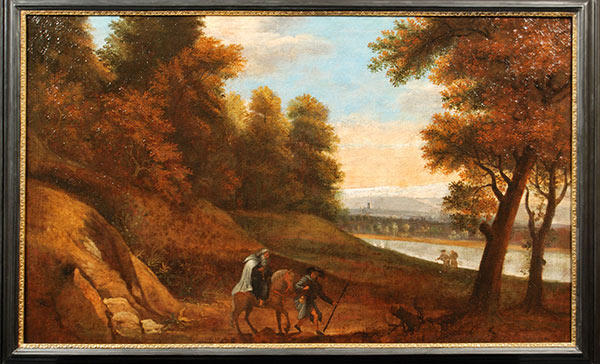
Willem van Bemmel
around 1660
oil on canvas
An old monk rides a horse, accompanied by a younger man whose large hat, staff and gourd bottle identify him as a pilgrim. Leaving the dark woods behind them, they arrive in a broad river valley. In the distance we can see buildings – a city, a castle or a monastery, possibly their journey's destination. Two other pairs of travelers are on the road ahead of them. The sky is beginning to redden in the evening light. Travel was laborious in the 17th century, and not without danger – as the artist knew from his own experience.
The artist
Willem van Bemmel was born in Utrecht, in the Netherlands, in 1630. He studied with landscape painter Herman Saftleven in Rotterdam, and moved from there to Venice in 1647, before the end of the Thirty Years' War. He remained in Venice for two years. He then lived for four years in Rome, also painting in such locations as Tivoli, before moving on to Naples. After traveling to England, he was employed around 1653 by the Landgrave of Hessen-Rotenfels, at Rheinfels Castle near St. Goar am Rhein. After a brief stay in Augsburg, in 1662 he settled in Nuremberg, where he married and worked as a painter until his death in 1708. He lived in the suburb of Wöhrd. Willem founded a highly regarded, productive family of artists in the city. Our landscape painting may have been made here in Nuremberg. He also joined his sons Johann Georg and Peter to paint landscapes from the environs, along with views of the city walls and suburbs, several of which can be seen in the Nuremberg City Museum.
Networks
Joachim von Sandrart, painter, copper engraver and great theorist of art, himself the son of a Dutch family, is thought to have encouraged Bemmel to move to Nuremberg. Sandrart probably obtained a teaching position for Bemmel at the art academy co-founded by Sandrart's nephew Jacob von Sandrart in 1662 – the first in Germany. In his great theoretical book "Die Teutsche Academie der Edlen Bau-, Bild- und Mahlerey-Künste" – "The German Academy of the Noble Arts of Architecture, Sculpture and Painting" – the elder Sandrart compiled the first biography of Bemmel, whom he praises warmly. Bemmel in turn esteemed his presumed mentor highly, and it may be no accident that he visited the same places where Sandrart had traveled before him: England, Venice, Rome, Naples, Augsburg and Nuremberg.
Style
Willem van Bemmel's visual imagery certainly contributes its own features to Baroque landscape painting. The human beings, subordinate to nature, guide the viewer into the painting's space as repoussoir figures. Deep perspective leads from the foreground across the river and into the distance; the various components are built up one behind the other like the flats in a stage set, yet combine visually to form a continuum that gives the viewer a broad general prospect. The handling of light, reminiscent of Jan Both and Nicolas Poussin, strengthens the effect still further: we look from the dark foreground into a brighter distance. The contrast of light and dark generates tension. The atmospheric, gradually paling evening light also shows the influence of Claude Lorrain, whom Bemmel certainly met in Rome. The painting's well-conceived layout, the dramatic lighting, the subtle use of color, show that Bemmel himself applied academic rules to painting. The understanding of a landscape has a literary parallel in the pastoral poetry of Nuremberg poet Sigmund von Birken, founder of the Pegnitz Flower Society (Pegnesischer Blumenorden) and Bemmel's close friend.



